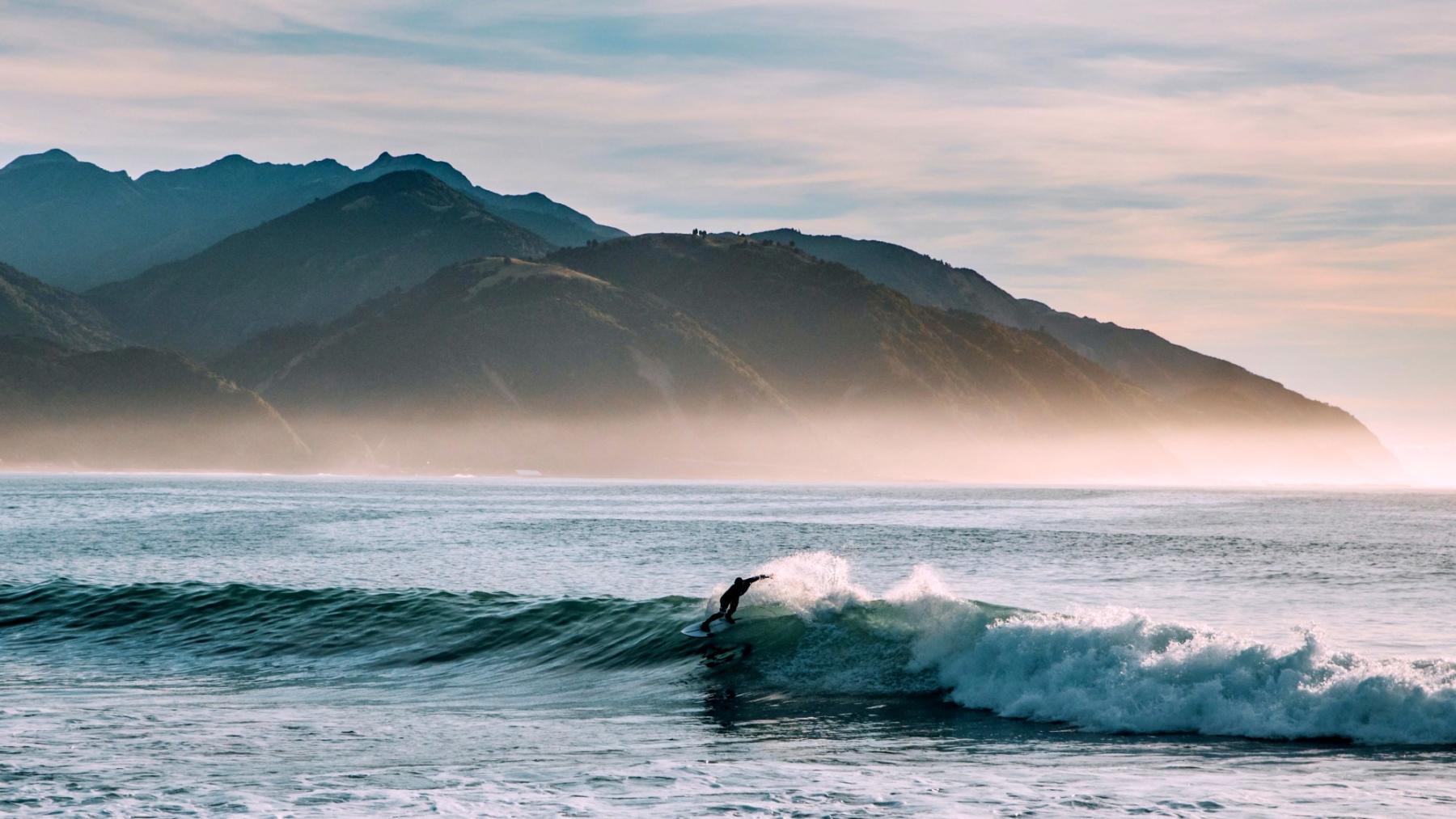
How to choose the right wetsuit for surfing and other water activities
Second only to a surfboard, a wetsuit is an essential component of your surfing kit. It insulates your body temperature so that you can surf or dive in a range of and protects your skin from irritation caused by surf wax and sand. And all of that means you get to stay in the water longer.
It’s important that you take into account a number of different factors before you decide which wetsuit is best for you. What season will you likely be using your suit? Where will you be surfing? What are the climate and weather conditions like there? Summer and winter surfing require wetsuits of different lengths and material thickness.
In this article, we'll break down which wetsuit is right for you and give you recommendations on how to choose one.
Climate and thickness
Consider the average water temperature and weather conditions you’re likely to encounter and make your choice accordingly. If you’re planning to do your surfing in a warmer climate, a spring suit — shorter and made of thinner material — may do the trick. Colder weather conditions will require a full suit that covers the body from the chin down to the wrists and ankles.
Temperature tolerance varies from person to person, but remember that if you don’t keep yourself warm, you’ll be cutting your time in the water short. Keep in mind some general guidelines for choosing suit thickness (measured in millimeters) based on water temperatures.
A 4/3 mm wetsuit with taped seams should keep you comfortable in mild to cold temperatures (55-65 degrees fahrenheit). Those who are especially tolerant to cold may find a 3/2 is enough.
Warmer water from 66-70 degrees is when your 2/1 or 3/2 thickness spring suit will come in handy.
For waters 70 degrees or more, you may feel comfortable in just your swimsuit, perhaps paired with a light jacket and/or rash guard, which offer protection against the sun as well as potential skin irritation from surf wax.
For very cold water, you might consider a wool-lined wetsuit, but be prepared to pay more upfront and for years of careful and extra diligent upkeep. Surfers who regularly go out in very cold water will want a dry wetsuit and accessories like a hood, booties, and gloves.
Types of neoprene
Wetsuits are made from a synthetic rubber material called neoprene, which helps keep you warm thanks to thousands of air pockets that maintain a layer of water between your skin and the suit itself. In addition to forming this barrier of insulation, neoprene is also buoyant, durable, flexible, and resistant to heat, UV rays, abrasion, flame, and many chemicals. In order to get the most out of these features, it’s important that you choose the right suit for you. Part of that is deciding between the different varieties of neoprene technology available on the market today.
- Nylon-Lined Neoprene Today’s basic wetsuits are lined with nylon jersey, which makes them easier to put on and take off in addition to protecting the neoprene from deteriorating as a result of the elements.
- Smooth Skin Neoprene This fairly common material traps in heat from your body and the sun while repelling water and wind. Cold water wetsuits often incorporate smooth skin neoprene in the chest and lower back areas to add to the body’s overall warmth in colder or windy conditions. These benefits come with a decreased durability, as this material is more likely to tear if it gets caught on rough objects like fingernails.
- Air Neoprene tends to be found only in the most high-end models. This technology includes an extra layer of fabric that makes these wetsuits warmer without being too thick or heavy.
- Yulex is a plant-based neoprene that is comparable in terms of warmth and flexibility but is a more environmentally friendly option for those wishing to factor sustainability into their decision-making.

Steven Wilcox / Unsplash
Size and fit
Fit is an absolutely essential component of finding the wetsuit for you. The effectiveness of a wetsuit relies on whether it fits you properly. If it doesn’t, it can’t do the job you need it to do.
A properly fitting suit is extremely snug. Excess space between your body and your wetsuit will allow too much water to get in and won’t insulate you from the cold. At the same time, you don’t want a wetsuit that’s so tight it restricts movement or circulation. It should hug your body without room to spare, but you should be able to freely move your arms when paddling.
Some materials stretch out over time, so buying a wetsuit that’s tight from the beginning ensures it’ll fit you for longer. Also check the length: a full suit should reach to the bottom of your ankles.
Consult with store staff and try on different suits while shopping. Be prepared to do a bit of work - wetsuits aren’t easy to squeeze into, but you’ll be glad you didn’t skip this step. Check them for flexibility and move your body around - is there enough but not too much room in the hips, crotch, arm and shoulder areas? Don’t rush this process. No matter how much you’re ready to dish out for a top-of-the-line wetsuit or if you’re looking at a budget rash guard, your suit will be ineffective if the fit isn’t right.
When checking for fit, also keep in mind what you plan to wear with or under your wetsuit. Some people prefer to wear a swimsuit, neoprene shorts, thermal lycra, or a rash guard under a wetsuit for extra insulation, or to layer up with a jacket if it’s extra cold or windy.
While you’re there, check all the details. Are the seams sewn carefully, or do they look haphazard and flimsy? For taped suits, is the tape securely affixed to the suit? Does the zipper move smoothly and comfortably in both directions? These details make a huge difference in the usage and longevity of your wetsuit and shouldn’t be overlooked.
Stitching, seams, and zip systems
Seams and stitching are an important component of a wetsuit. A high-quality wetsuit’s stitching will be done meticulously so that the tiny perforations in the neoprene don’t interfere with the suit’s ability to retain body heat.
Stitching
Overlock is the simplest and least effective type of wetsuit stitching, and it’s typically only found on lower-end models suitable for warmer temperatures. The fabric panels are rolled and then stitched together, making for a relatively bulky seam that isn’t very flexible.
Flatlock stitching is done through two panels of neoprene that have been layered, rather than rolled, creating a durable and flexible seam. However, this method is less effective at preventing water seepage and is better for summer suits.
Blindstitch involves layering the panels of fabric on top of each other and gluing them together before stitching only on the outside of the panels, not puncturing all the way through. This results in seams that are both flexible and watertight, a feature that costs more but is a great option for cold water surfing. Double blindstitching refers to the same process done to both sides of the fabric.
Seams
Glued seams are first glued and then stitched, lending the suit a strong and waterproof seal.
Soft taped seams feature taping at certain points in your wetsuit that would benefit from the added reinforcement.
Fully taped refers to taping along all of the seams.
Zipper systems
Back zips allow for a larger open area to get into and out of, but the zipper down the center of the back decreases flexibility and restricts arm movement.
Chest zips eliminate the flexibility problem and make paddling and getting up and down more comfortable. The downside is that they’re harder to get into and out of.
Zipperless wetsuit models are the stretchiest and most flexible, but they aren’t easy to get on and off.

Tim Marshall / Unsplash
Wetsuit care
Regardless of how much you spend or how well you take care of your wetsuit, you can only expect to get so many (about 5) solid years of good use out of it. Still, it’s important to take care of your suit so that it stays in as good a condition as possible for as long as possible
1. Always rinse your wetsuit. After each use, thoroughly rinse your suit with cold water, inside and out, to clean off any trapped sand and dirt (but try to remove most of the sand outside first to prevent clogging any indoor plumbing). Note that hot water can deteriorate the material. Avoid machine washing and any detergents, soaps, or softeners that aren’t specifically meant for wetsuits. There are products on the market specifically suited for neoprene; otherwise use something very gentle such as baby shampoo.
2. After rinsing, hang your wetsuit away from the sun. Prolonged sun contact will deteriorate your suit’s lifespan, so it’s best to hang it up in the shade or indoors. If you need it to dry quickly in the sun, make sure to turn it inside out first to protect the outside material and color. Drape your wetsuit over a wide plastic (not wire) hanger at the waist, never by the shoulders, to avoid stretching the material.
3. Remove wax with ice water. Soak your suit in a bucket of ice water until the paraffin hardens enough to peel off a little at a time. Remove wax by hand, never with a brush.
4. Store your suit properly. For longer periods of storage, hang up your suit (again, by the waist rather than the shoulders). Folding your suit will cause it to crease. Investing in a special wetsuit hanger can help prolong the life of your suit and keep its shape.
Our top wetsuit picks
Now that we’ve covered some of the basics, here are some of our tips picks for the best wetsuits on the market. Our top picks for wetsuits combine flexibility, drying time, warmth, and comfort.
Best man's wetsuits
- O'Neill Men's 3 / 2 mm Reactor Full Wetsuit
- Rip Curl Flash Bomb Plus 3/2 mm
- Patagonia R3 Yulex Front Zip Full Suit
Best woman's wetsuites
- Roxy Syncro 3 / 2 mm Back Zip Flatlock Wetsuit
- O’Neill Women’s Reactor 3 / 2 mm Full Surfing Wetsuit
- O'Neill Hyperfreak 3 / 2 mm Chest Zip Full Wetsuit
Best beginners wetsuites
- Rip Curl Mens Omega 3 / 2 mm Flatlock Back Zip Wetsuit
- Billabong Womens Launch 3 / 2 mm GBS Back Zip Wetsuit
- Quiksilver Prologue 5 / 4 / 3 mm Back Zip Wetsuit
Best winter wetsuits
- Quiksilver, AG47 Performance 4/3mm Chest Zip Steamer
- Patagonia, R2 Yulex FZ Full Suit Hurley, Phantom Limited 202 Wetsuit
- Hurley, Phantom Limited 202 Wetsuit
This post was originally published on the Windy.app blog on August 1, 2019.
Learn more about how to read the surf / swell forecast in a special Windy.app presentation with examples and tips from professional surfers with many years of experience of riding the biggest and best waves on the planet.
Text: Windy.app team
Cover photo: Shutterstock
You will also find useful
Latest News
Professional Weather App
Get a detailed online 10 day weather forecast, live worldwide wind map and local weather reports from the most accurate weather models.
Compare spot conditions, ask locals in the app chat, discover meteo lessons, and share your experience in our Windy.app Community.
Be sure with Windy.app.



